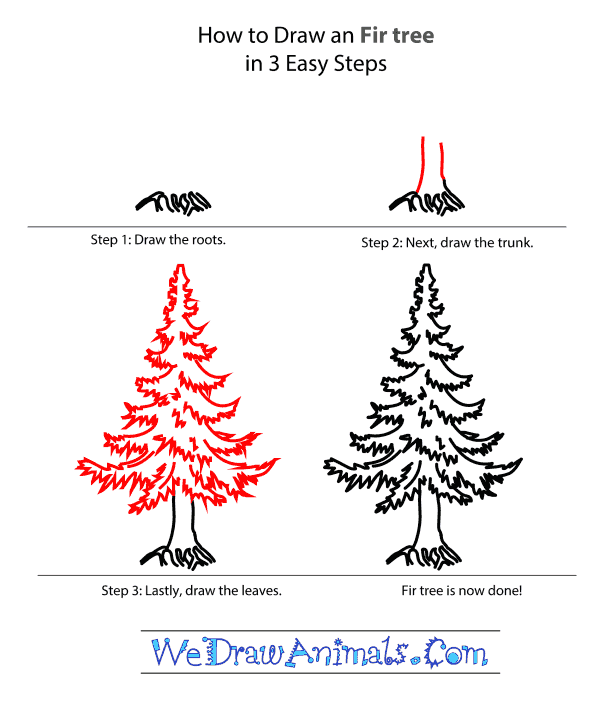In this quick tutorial you'll learn how to draw a Fir Tree in 3 easy steps - great for kids and novice artists.
The images above represents how your finished drawing is going to look and the steps involved.
Below are the individual steps - you can click on each one for a High Resolution printable PDF version.
At the bottom you can read some interesting facts about the Fir Tree.
Make sure you also check out any of the hundreds of drawing tutorials grouped by category.
How to Draw a Fir Tree - Step-by-Step Tutorial
Step 1: Start by drawing the roots. Draw a few small slanted lines in a bunch.
Step 2: Next, draw the trunk. The trunk isn’t too big because the leaves cover most of it. Draw a medium sided, straight lines coming up from both sides of your roots.
Step 3: Lastly, draw the leaves of your tree. Figure out how tall you want your tree to be and start there. Draw a small upside down “V” at the top of where you want your tree to be. Start on the right side of the “V” and draw a small curved line going out and then a zigzag line going back in towards the tree. Keep doing this in a slanted line and make the curves longer as you go down the tree. Stop when the bottoms of your leaves are right across from the top of your trunk. Now make one last curved line with a zigzag bottom smaller than your last leaf. Make it connect to the trunk. Repeat these steps on the left side. Draw a few zigzag lines inside of the outline of your tree to make the leaves pop.
Interesting Facts about Fir Trees
Fir Trees are tall evergreens that are cone shaped and covered in needles. They grow in a lot of sizes depending on the tree. A Fir Tree can be 15 to 200 feet tall, and they all produce cones to pollinate themselves. The cones on a Fir Tree are normally 6 to 8 inches long. The needles on a Fir Tree range from 1 ? to 6 inches long. Fir Trees grow naturally in North America, Europe, Asia, and Northern Africa. Common Fir Trees are the Douglas Fir, the Grand Fir, the Red Fir, the Balsam Fir, and the Silver Fir. What makes a fir tree recognizable is the brush like branches that give the tree pointy edges. Other evergreens are more rounded on the edges.
Did you know?
- Fir Trees are natural choices for Christmas Trees. Douglas Firs and Balsam Firs are grown on tree farms just for Christmas decoration.
- Fir Trees have very short roots, so they break easy during wind storms.
- There are 50 species of Fir Tree.
- Fir Tree Appreciation Day is June 18th.
- Deer really, really, really like to eat the bark of Fir Trees. If they aren’t careful the tree will die.
Theme: Fir Trees are the perfect topic for a Christmas time lesson plan. First decide which tree you want to highlight this Christmas. Then set up the evergreen of your choice. Let your students decorate the tree and while you are at it create a science lesson on the Fir Tree.




